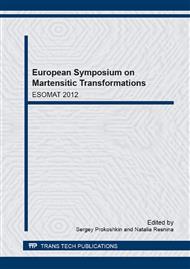p.167
p.172
p.177
p.183
p.189
p.195
p.200
p.206
p.212
Influence of Omega-Phase Precipitation Hardening on the Static and Dynamic Properties of Metastable Beta Ti-Nb-Zr and Ti-Nb-Ta Alloys
Abstract:
The influence of thermomechanical processing on the Ti-21.8Nb-6Zr (TNZ) and Ti-19.7Nb-5.8Ta (TNT) (at%) alloys’ structure, phase composition, mechanical and functional properties is studied. Both alloys possess polygonized dislocation substructure (average subgrain size 100 nm), and manifest superelastic behavior at room temperature and recovery stress generation during constant-strain temperature scanning experiments. After aging treatment, both alloys were -phase precipitation hardened, but their mechanical behavior was impacted differently -- it was detrimental for TNZ and beneficial for TNT. The different impact of aging heat treatment on the mechanical behavior of these alloys is explained by the differences in the -phase nucleation rate, precipitates’ size, shape, volume fraction and distribution, and by their effect on the alloys’ critical stresses and transformation temperatures.
Info:
Periodical:
Pages:
189-194
Citation:
Online since:
January 2013
Price:
Сopyright:
© 2013 Trans Tech Publications Ltd. All Rights Reserved
Share:
Citation:


